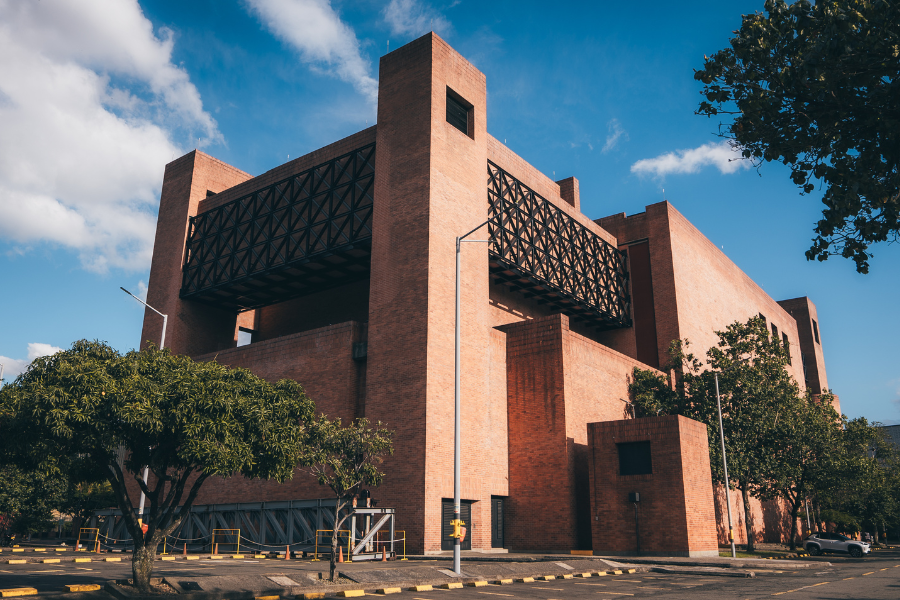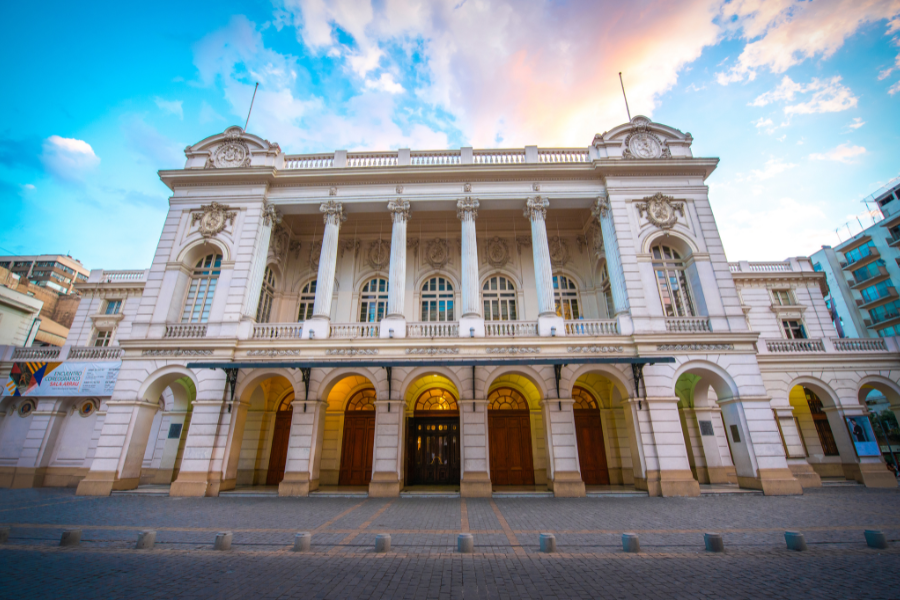Teatro Mayor Julio Mario Santo Domingo: Cultura y filantropía para tiempos actuales

Inaugurado un 26 de mayo de 2010, el Teatro Mayor se ubica en el Centro Cultural Biblioteca Pública Julio Mario Santo Domingo en el sector norte de Bogotá, Colombia. El teatro mantiene un enfoque programático que incorpora obras de diferentes medios y expresiones artísticas, desde lo folclórico y popular hasta lo docto y experimental, representadas en un moderno espacio de equipamiento tecnológico. En sus más de trece años de historia, el Teatro Mayor conjuga una perspectiva contemporánea con un origen enraizado en la colaboración público y privada.
por Macarena Robledo
Inserto dentro del Centro Cultural Biblioteca Pública Julio Mario Santo Domingo, el Teatro Mayor fue inaugurado gracias al esfuerzo conjunto del sector público y privado.
Con el apoyo de cogestores públicos y privados, la Alcaldía de Bogotá, a través de la Secretaría de Cultura Recreación y Deporte y del Instituto Distrital de las Artes – IDARTES, y la familia Santo Domingo, además de aliados transversales ccomo Bancolombia y Caracol Televisión, el apoyo de Sura y el Grupo Energía de Bogotá, de la Cámara de Comercio de Bogotá y las donaciones de las Fundaciones Ramírez Moreno, el Teatro Mayor mantiene un enfoque programático que incorpora obras de diferentes medios y expresiones artísticas, las cuales transitan a través de lo folclórico, popular, docto y experimental.
Más de trece años de historia
El Centro Cultural Biblioteca Pública Julio Mario Santo Domingo es un complejo de 23 mil metros cuadrados situado en un parque público de 5 hectáreas y media. Está integrado por una biblioteca con capacidad de 150 mil libros; por el Teatro Mayor, recinto especializado en conciertos y espectáculos de gran formato (ópera, ballet, zarzuela, circo, teatro, etc.), y el Teatro Estudio, sala multipropósito en la que se presentan conciertos de música de cámara y espectáculos escénicos experimentales.
Es una infraestructura pública de la Alcaldía de Bogotá que fue donada por la familia Santo Domingo al Distrito Capital. La administración del complejo teatral se realiza a través de un novedoso esquema de gestión público-privado que permite, bajo un enfoque jurídico de corresponsabilidad, aunar esfuerzos para hacer realidad un proyecto cultural de gran calado en el marco de la política pública.
La gestión, operación y funcionamiento de los teatros se realiza mediante un convenio de asociación suscrito entre la Alcaldía de Bogotá y la familia Santo Domingo, buscando garantizar la sostenibilidad y la inclusión. Los teatros hacen parte de la red de escenarios de Bogotá cuya administración está a cargo del Instituto Distrital de las Artes IDARTES, entidad adscrita a la Secretaría de Cultura, Recreación y Deporte de la ciudad. La operación de las salas teatrales está a cargo de la Fundación de Amigos del Teatro Mayor FATM, en los términos de la alianza suscrita con estas entidades.
Se cuenta con dos órganos de gobierno en los que participan tanto los cogestores públicos como privados: un Comité Directivo y un Comité Fiduciario. Desde el inicio de las operaciones se acordó que los recursos privados se destinan al funcionamiento del escenario y los públicos a la programación artística.
Para la ejecución del proyecto, se convocó al arquitecto Daniel Bermúdez, un reconocido urbanista que ya había participado en la construcción de otras de las bibliotecas públicas y edificaciones icónicas de la ciudad. Fue en este punto que, atendiendo a la necesidad social de contar con un nuevo espacio para las artes escénicas en el sector norte de Bogotá, se planteó a la familia Santo Domingo reformular el proyecto de la megabiblioteca para, en su lugar, destinar los recursos de su donación a la construcción de un centro cultural que, además de un espacio para la lectura, contara con un teatro. Tras evaluar en conjunto con Bermúdez la factibilidad de edificar un teatro de nivel mundial, capaz de albergar una multiplicidad de manifestaciones artísticas, la familia Santo Domingo autorizó la construcción del nuevo complejo que hoy lleva el nombre de la cabeza de la familia.
La propuesta se concretó de forma definitiva el día 30 de mayo de 2007, fecha de la colocación de la primera piedra del nuevo centro cultural. Finalmente, casi tres años exactos más tarde, el Teatro Mayor Julio Mario Santo Domingo abrió sus puertas el 26 de mayo de 2010, con un concierto inaugural que estuvo a cargo de Orquesta Filarmónica de Bogotá, la soprano María Alejandres, el tenor Juan José Lopera, el bajo-barítono Valeriano Lanchas, el Coro de la Ópera de Colombia y la Sociedad Coral Santa Cecilia.
Desde entonces, el teatro se ha transformado en uno de los principales escenarios de Colombia, contando con una proyección internacional que lo ha consolidado, según ha sido expresado por medios como la Radio Nacional de Colombia, “como un promotor del diálogo entre las culturas de Colombia y el mundo”. Convertido en un modelo de financiamiento y gestión público-privado en el ámbito escénico del Cono Sur, el Teatro Mayor se enorgullece de combinar una programación de excelencia sin descuidar el compromiso que establece con el resguardo de los derechos culturales de la ciudadanía, promoviendo la difusión de las artes a diversos públicos, por medio de iniciativas y programas sociales.
Un escenario con perspectiva contemporánea
Ubicado en un complejo de cerca de 23 mil metros cuadrados de extensión, el Centro Cultural Julio Mario Santo Domingo está integrado por tres espacios principales: la Biblioteca, el Teatro Mayor y el Teatro Estudio. Destinado a espectáculos de gran envergadura, el Teatro Mayor posee una capacidad para 1.303 espectadores. El foso para orquestas se puede elevar para ampliar el escenario o quedar a nivel de la platea para ampliar la capacidad.
En un nivel más específico, de acuerdo con Bermúdez, el Teatro Mayor fue construido pensando en garantizar la comodidad tanto del público como de los artistas. Esto queda de manifiesto en aspectos como los amplios camarines, salas de calentamiento y foso para la orquesta; la cuidada disposición de las butacas en la sala –configurada para lograr una adecuada visibilidad desde diversos puntos de esta–; y la complejidad de la tramoya, que posibilita la realización de diversos efectos lumínicos, escenográficos y mecánicos.
Una característica que distingue al Teatro Mayor de otros escenarios –particularmente de aquellos de carácter patrimonial– es su aprovechamiento de las nuevas posibilidades tecnológicas de la actualidad. Así, además de las modernas luminarias y elementos de control sobre el escenario, destaca el complejo sistema de sonido que, implementado en noviembre del año recién pasado, cuenta con más de una treintena de altavoces y subwoofers encargados de garantizar una experiencia de audición envolvente de alta calidad y fidelidad, cuyas herramientas de control y procesamiento son enteramente digitales.
De hecho, a finales de 2023, el Teatro Mayor tuvo una actualización de su sistema de amplificación acústica: se adquirió un sistema de la marca d&b audiotechnik con 34 altavoces de la serie XSL8 con módulos de procesamiento digital. Este sistema está a la vanguardia tecnológica en materia de eficiencia y directividad del sonido.
Otro sector emblemático en este complejo es el Teatro Estudio, un espacio tipo box con capacidad máxima de 329 espectadores, que está dotado con silletería retráctil, lo que permite convertir el teatro en un espacio vacío ideal para presentar obras interactivas no convencionales, clases magistrales de danza o exposiciones, entre otras.
Diversidad en la programación
Precisamente esta serie de implementaciones tecnológicas ha permitido que el Teatro Mayor se convierta en un espacio idóneo para la puesta en escena de un repertorio tan variopinto y heterogéneo como el que conforma la programación habitual de este espacio. Subdividida en cinco temporadas –a saber, temporadas de música, danza, teatro, festivales y familiar– la diversidad histórica, estilística y medial de los espectáculos responde directamente al interés de la administración del teatro por propiciar un diálogo cultural plural. De este modo, el escenario alberga presentaciones que van desde la música clásica a la popular, pasando por la ópera, danza, ballet, teatro, e incluso circo y espectáculos misceláneos.
Un objetivo prioritario del Teatro es la formación de futuros espectadores por medio de programas dirigidos a niños, jóvenes y familias, orientados a atraer al público vecino del Teatro y a quienes no tienen posibilidades económicas o un interés natural en las actividades culturales.
En esa línea, el Teatro Mayor cuenta también con un componente de mediación que ofrece información de contexto relevante para enriquecer la experiencia. Un ejemplo es el programa social Teatropedia, que ofrece actividades para el colegio y la familia a partir de las artes escénicas.
La programación musical incluye las temporadas sinfónica, lírica, temporada de jazz, de “grandes solistas”, “voces del mundo” y “Colombia es música”, programaciones que, además de confrontar el ámbito docto con el popular e incluso folklórico, son desarrolladas gracias a la participación de diversos exponentes musicales tanto colombianos como extranjeros, permitiendo la vinculación internacional del centro cultural. Esto último se ha visto reflejado, por ejemplo, en la realización de producciones como Rigoletto (2015) y Orfeo y Eurídice (2017), presentadas en Colombia gracias al acuerdo de colaboración entre el Teatro Mayor y la Opernhaus Zürich.
Más recientemente, el Teatro Mayor ha presentado La vida es sueño (2023), ópera de Juan Pablo Carreño con libreto de Iván Olano basada en la obra de Pedro Calderón de la Barca y que fue llevada a cabo en coproducción con el Festival Iberoamericano del Siglo de Oro “Clásicos en Alcalá” y la orquesta La Chapelle Harmonique. Otro clásico de la ópera que ha subido al escenario del teatro en periodos recientes es El caballero de la rosa (2018), de Richard Strauss, con libreto de Hugo von Hofmannsthal, y que también fue una coproducción, esta vez con la Ópera de Colombia, el Teatro Municipal de Santiago y la Orquesta Filarmónica de Bogotá.
De modo similar, la programación de danza presenta año a año algunas obras de la tradición del ballet clásico, pero también producciones de danza contemporánea, flamenco y danzas del folclor colombiano. Adicionalmente, el teatro alberga una temporada de teatro hablado o de tablas, que año a año realiza una propuesta que encierra títulos tanto del teatro clásico o “universal”, hasta nuevas creaciones de dramaturgos y directores colombianos y extranjeros.
Así, con más de una década de actividad, el Teatro Mayor Julio Mario Santo Domingo, cuyo director general actualmente es Ramiro Osorio Fonseca, ha logrado posicionarse como una iniciativa de participación pública, que es financiada y administrada siguiendo un modelo de aportes mixto.
Para graficar esto último, la estadística señala que solo en su primera década de vida el teatro realizó más de 1.536 funciones, con la participación de 35.063 artistas de 957 compañías provenientes de 66 países, y consolidó un total de 27 coproducciones. Un número que sigue en aumento y que lo proyecta como un espacio de abultada actividad artística.










